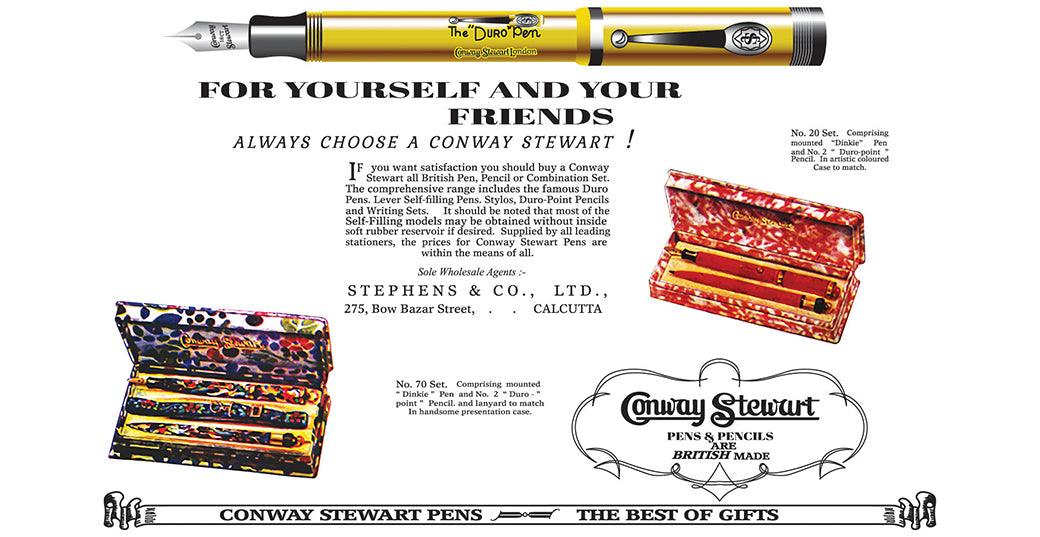Conway Stewart has been a leading fountain pen manufacturer since its founding in 1905, producing high-quality writing instruments with exceptional craftsmanship. One of its most coveted collections is the Duro Collection, which was first introduced in the 1920s. This collection is renowned for its durable and robust design, making it an ideal choice for daily use. The fountain pens in this collection are crafted from solid brass and celluloid, with intricate engravings that showcase the brand's attention to detail.
The Duro Collection's name comes from the Latin word "duro," which means "hard" or "durable," or “tough” a testament to the pens' construction. This design, coupled with its classic style and elegant look, make the Duro collection perfect for writing letters, journaling, or taking notes.
One of the reasons for the Duro Collection's popularity is its versatility. Collectors have a wide range of options, from different colours and finishes, making it easy to find a pen that perfectly suits their needs and personal style.
History
The post-World War I economic boom saw consumers demanding products that were both practical and refined. Technological advancements led to a surge in the availability of personal goods that reflected individual taste and status. Writing instruments, once purely utilitarian, became more colourful with new ways of ink filling. Consumers were drawn to products that showcased sophistication, durability, and modern convenience.
For the professional and the everyday writer, the 1920s offered an exciting variety of new designs. Propelling pencils, in particular, gained popularity due to their innovative lead advancement systems, which removed the need for sharpening. This mechanism aligned well with the era’s emphasis on efficient and elegant solutions.
By the early 1920s, Conway Stewart aimed to offer products that could meet the growing demand for both functional and stylish writing tools.
The Duro-point was introduced in 1922 as an “all-new magazine pencil perfectly balanced with fine leads - always sharp and a rigid point”. The Duro - point pencil was the first of a long line of pencils sold by Conway Stewart . It was also the first of their products to be available in a wide range of colours and was sold with a detachable unmarked nickel-plated pocket clip. The propel/push-repel mechanism was patented by Frederick Bina and Francis Barrey who made the mechanisms and assembled the complete pencils at their factory in Islington, North London from barrels and other parts supplied by Conway Stewart. Bina and Barrey would continue to work collaboratively with Conway Stewart making pencils for the next 45 years, during which time they registered at least 20 UK patents relating to pencil mechanisms.
In Autumn 1924, the Duro pen was introduced as an “oversized” fountain pen and by 1925 was available with Conway Stewart’s new patented “locking lever” device which becomes the standard filling system in the majority of Conway Stewart pens. In 1926, a smaller version of the Duro was launched called the Duro No 2 and the larger pen was renamed as the Duro Pen No 1.
The Duro Series in both fountain pen and propel/repel pencil won wide appeal due to their technological innovation and the range of colours available.
By mid-1928 saw pencils introduced to match the Duro Nos 1 and 2, featuring a ball-end clip, a long cone section, and a large 'crown.' At around the same time, the Duro pens and the Conway pencils were available in new colours, such as casein, Lapis Blue, Grey Jazz and Jade Green, making the collection even more versatile and sought after by fountain pen collectors.
Today
In summary, the Conway Stewart Duro Collection is a timeless classic that has been a favourite among fountain pen collectors for many years. With its durable design, classic styling, versatile range of options, and constant improvements over time, it's no wonder why these pens are so highly sought after. Whether you're a seasoned collector or a newcomer to the world of fountain pens, the Duro Collection is a must-have addition to any collection.


Leave a comment